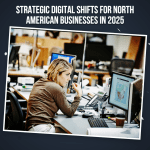In today’s hypercompetitive digital economy, North American businesses are under increasing pressure to differentiate not just through products and services, but through their ability to connect meaningfully with customers. One of the most impactful shifts in brand strategy over the last five years has been the rise of community marketing — a model that prioritizes customer loyalty, advocacy, and participation over traditional advertising expenditure. As global brands pivot toward community-centric models, small and medium-sized enterprises (SMEs) in Canada and the United States are presented with a strategic opportunity to reimagine engagement, growth, and brand equity.
From impressions to influence: A strategic marketing evolution
Historically, brand success was often measured by advertising impressions, reach, and frequency. Today, those metrics are giving way to more nuanced performance indicators such as customer lifetime value, referral rate, and net promoter score. This change reflects a larger shift in marketing logic: the realization that influence, not visibility alone, drives modern purchasing decisions.
Large-scale brands like MrBeast’s Beast Industries have demonstrated how cultivating a passionate community can rival or even outperform multi-million dollar ad campaigns. Rather than push messaging to passive audiences, these brands foster environments where customers actively engage, contribute, and promote.
This is not just a consumer trend. It is a transformation in business architecture.
Understanding community-first marketing
Community marketing is a long-term strategy focused on developing meaningful relationships with customers, encouraging dialogue, co-creation, and loyalty. It spans beyond traditional CRM or customer support initiatives. Instead, it integrates community management, social media engagement, user-generated content, and feedback-driven product development into the core of brand operations.
Key components of a successful community marketing strategy include:
- Direct engagement and transparency: Brands must share their processes, values, and goals with honesty and clarity.
- User-generated content and recognition: Encouraging customers to share experiences while publicly acknowledging their input builds credibility and trust.
- Incentive-driven advocacy: Providing tangible and emotional rewards for customer participation strengthens loyalty.
- Owned platforms for interaction: Whether through private groups, forums, or branded apps, these platforms allow brands to facilitate ongoing interaction and support.
- Continuous feedback loops: Community members often become informal product testers and brand advisors, offering insights that are both timely and authentic.
Strategic benefits for North American SMEs
While community marketing has gained traction among global brands, it holds particular value for small and medium-sized enterprises in North America. These organizations often possess proximity to their customers, greater agility, and the ability to foster authenticity — all essential for effective community engagement.
1. Cost-effective growth
With advertising costs increasing due to platform saturation and algorithmic unpredictability, community marketing offers a sustainable alternative. Organic reach through word-of-mouth, referrals, and social sharing can significantly reduce customer acquisition costs over time.
2. Resilient brand equity
Communities are more than marketing channels. They are ecosystems of trust. During times of crisis, algorithm changes, or competitive disruption, a well-nurtured community provides stability and support that traditional ads cannot match.
3. Enhanced product development
Community members are often early adopters and key feedback providers. Their input helps shape offerings, correct blind spots, and ensure product-market fit before large-scale rollouts. This reduces risk and improves innovation cycles.
4. Higher customer retention
Customers who feel seen, heard, and valued are significantly more likely to stay loyal. Community-centric strategies elevate the customer experience from transactional to relational, directly impacting retention and repeat purchase metrics.
Case studies: Local examples of global strategies
Several North American SMEs have already begun leveraging community-first frameworks with measurable success:
- A Canadian wellness brand built an invite-only Slack group for product users. The group became an innovation lab and review engine, increasing customer retention by over 40 percent.
- A New York-based artisanal food company launched a referral challenge with minimal budget but high community participation. It resulted in a 300 percent uptick in organic sales within a quarter.
- A Vancouver fitness studio used Instagram stories and polls to source feedback and co-create classes. Their community engagement led to a 25 percent increase in class bookings within six months.
Implementing a professional community strategy
For SMEs considering a transition to community-first marketing, it is crucial to treat the initiative as a business function, not a campaign. This means investing in dedicated resources, clear KPIs, and integration across departments.
1. Start with audience segmentation
Identify your top-tier customers or early adopters. These will form the nucleus of your community and help establish its tone and norms.
2. Define your value exchange
What will customers gain from participating? This could be access to exclusive content, discounts, early releases, or recognition. The perceived value must outweigh the required effort.
3. Choose the right platform
Use platforms your audience already uses. This may include Facebook Groups, Discord, or purpose-built community tools. Maintain a professional tone aligned with your brand, and ensure it is well-moderated and consistent.
4. Build feedback into operations
Community insights should be systematically shared with product, support, and leadership teams. Document and track community-generated improvements and credit members where appropriate.
5. Scale gradually and measure performance
Establish KPIs tied to engagement, referrals, satisfaction, and conversion. Use CRM and analytics tools to measure and refine the impact of your community efforts.
Final thoughts: a future-facing imperative
The trend toward community-driven marketing is not a passing phase. It reflects a broader shift in how consumers want to interact with brands — not as passive recipients, but as co-creators and collaborators. For businesses in Canada and the United States, adopting this model is not just a matter of trend alignment. It is a strategic imperative to future-proof their growth.
By focusing on authenticity, long-term relationship building, and customer empowerment, SMEs can carve out resilient, scalable marketing pathways that evolve with their audiences. Community-first brands are not just more connected. They are better equipped for the future of commerce.
Let your community be your competitive advantage. In 2025 and beyond, the strongest brands will be those built together with the people they serve.









